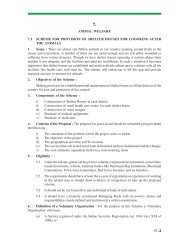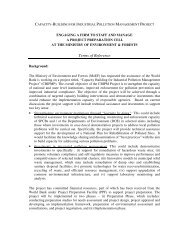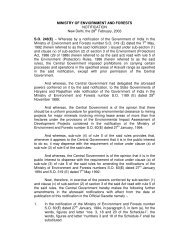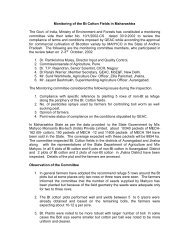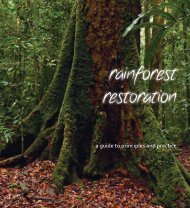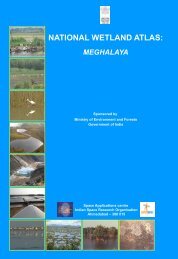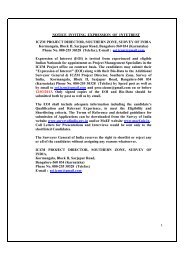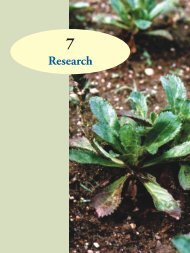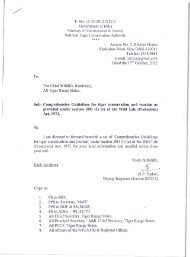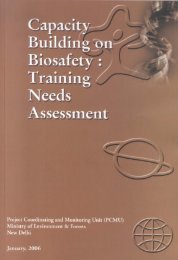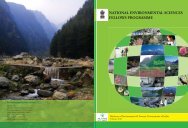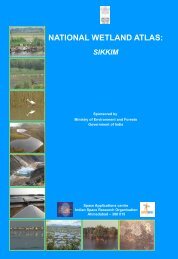REVIEW OF GREENHOUSE GAS EMISSIONS FROM THE ...
REVIEW OF GREENHOUSE GAS EMISSIONS FROM THE ...
REVIEW OF GREENHOUSE GAS EMISSIONS FROM THE ...
Create successful ePaper yourself
Turn your PDF publications into a flip-book with our unique Google optimized e-Paper software.
A theoretical estimate based solely on a relationship between average net primary productionand latitude [Net Primary Production (NPP - g C per m 2 per yr) = 852 – 11.7*latitude] 6 , andassuming that 20% of NPP is embedded in the sediments 7 , gives a net burial of about 100gCper m 2 annually. However, because of the low concentration of nutrients, it is likely that thisamount overestimates the carbon storage in the Khab Reservoir.Warm temperate forests in their natural state is estimated to contain 371t C/ha 8 . The forestsalong the Sutlej River have been heavily logged and largely consist of shrubs nowadays.Erosion has probably depleted the soil organic matter, including litter and debris. In addition abroad zone on both sides of the river is barren due to the annual flooding. Perhaps less than200 t C/ha remains. This means that the Khab reservoir, unless the area is cleared ofvegetation, would inundate 200,000 t of carbon at most. The decomposition of floodedvegetation is usually completed in less than 10 years, when about 50 % of the organic matterhas disappeared. The remaining fraction is resistant and will not contribute significantamounts of greenhouse gas.How much of the carbon will be emitted as methane to the atmosphere? Since the averagedepth of the reservoir is 62.5m methane emissions through bubbling need not be considered.The only mechanisms that would release methane to the atmosphere are diffusion through thewater mass or degassing below the power station. The importance of these two pathwaysdepends on the oxygen content near the bottom of the reservoir.The inlet to the reservoir will be well oxygenated at all times. The renewal rate of thereservoir in winter is about 70 days, while in the summer it is only 7 days. Methane formationis a slow process compared to aerobic degradation of organic matter. It is likely that oxygenwill be sufficient to prevent methanogenesis in the winter since the reservoir will not bestratified at this time of the year and because of the low temperature. In the summer, on theother hand, when the risk of stratification of the water mass is normally larger, the waterrenewal rate will most likely be high enough to replenish well oxygenated water and preventmassive methane formation.This rough estimate indicate that without forest clearance the specific emissions of CO 2 fromthe Khab Power station would be in the order of 1g per kWh (given an estimated annualenergy generation of 3522 GWh and a reservoir life expectance of 100 years). This figure willbe even lower if the entire cascade of power generation is considered. If we assume that 5%of the carbon will be emitted as methane, the specific emissions will reach about 1.5g CO 2 -equivalents per kWh; not considering the carbon permanently buried in the sediments.3.0 Design Criteria that could Reduce Methane EmissionsIt is unlikely that reservoirs and power stations in the Sutlej River will emit large amounts ofmethane, the only GHG that needs to be considered in hydropower projects. Because of thesteep river valleys in the Himalaya region, depth will always be large enough to prevent6 Lewis, W. M., Jr. (1987). Tropical limnology. - Annual Review of Ecology and Systematics 18:159-184.7 Information given at the UNESCO/IHA workshop in Iguaçu, Brazil in October 2007.8 Estimates of preanthropogenic carbon storage in global ecosystem types compiled by Jonathan Adams,Environmental Sciences Division, Oak Ridge National Laboratory, TN 37831, USA.9



